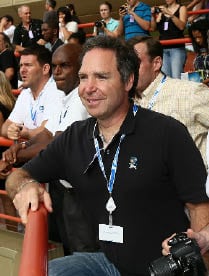Latest News
The satellite industry is entering a new era where high-speed satellites are becoming the norm. We talk to some of the key visionaries about satellite’s future.
When asked about the world’s growing dependence on satellite connectivity, Vern Fotheringham is a bit circumspect. Noting that the industry was built on massive amounts of capital being deployed to put assets into orbit, often at the expense of innovation on the ground segment, he points to the speed of innovation by terrestrial wireless providers. “The cellular industry has probably gone through 12 generations of technology shift; we’ve gone through one and a half,” he observes dryly.
Fotheringham, CEO of Redmond, Wash.-based Kymeta, which was just named a 2014 FiRe starter company, is close to commercializing its next-generation flexible antenna, which could very well usher in a new era of ubiquitous mobile broadband.
His observation is shared by other industry leaders, including Greg Wyler who founded O3b in 2007 to bring connectivity to the unconnected. His startup’s Medium Earth Orbit (MEO) architecture has dramatically reduced the delay traditionally associated with satellite connectivity, but even with the innovation inherent in his system’s architecture, Wyler is quick to say that O3b didn’t push the envelope of technology too far. “Okay, we pushed boundaries for space but the guys over in the mobile world are yawning,” he says.
According to Wyler, the breakthrough for O3b was rejecting the industry’s obsession with “space-qualified hardware” while pushing the envelope of “systems thinking and understanding our customer base.”
Fotheringham and Wyler are among a handful of industry visionaries, including Mark Dankberg, founder and CEO of Viasat; Samer Halawi, CEO of MSS operator Thuraya; Amiee Chan, president and CEO of Norsat; and Thomas Choi, co-founder and CEO of ABS, who talked with Via Satellite about the future of the industry.
As two of these executives have illustrated, the satellite sector, when compared with the lightning fast changes in the cellular industry, seems to be going at a tortoise’s pace. In an industry that grew up being driven by military requirements, operators historically had to focus on reliability, space readiness and exacting hardware requirements at the expense of agility, innovation, or keeping on schedule or on budget.
However, with the debut of the first generation of high-throughput satellites, such as ViaSat 1 in early 2012 and new waves of innovation and convergence on the ground, satellites are finally poised to realize their full potential as a compelling, cost-effective answer to the world’s insatiable hunger for communications and broadband. In the Q&A below, some of satellite’s notable risk takers and innovators shed light on how far the industry has come and what operators, manufacturers and other players need to do to ensure satellite’s rightful place at the connectivity table.
Via Satellite: What is driving the growing dependency of the world on satellite technology?
Wyler: Connectivity, connectivity, connectivity. What’s happened is everyone understands a fundamental truth: without connectivity, no village can be economically relevant. If you don’t have connectivity, you can’t have economic growth that relieves the baseline issues of humanity. There is no other technology [than satellites] that allows you to bring access to so many people over such long distances.
Dankberg: I’m not sure there is a growing world dependency. I think there is an opportunity for it, but there is also an opportunity for things to go the other direction if we don’t do a good job. The opportunity is to best meet people’s demands for communications and entertainment and mobility and convenience. There are hurdles; this is not something satellites are entitled to… or will happen if the industry isn’t responsive to what people want.
Halawi: There is more awareness of what satellite technology can bring and more and more demands for it. One, people are communicating more often and more people want to communicate. Two, satellites have advantages over terrestrial from an economic and coverage point of view that will always be there. Three, there are more disasters, natural and man-made, and satellite is an ideal solution for providing connectivity.
Chan: Applications for satellite technology are becoming ubiquitous; from the traditional role in the broadcast and telecommunications fields, to applications such as broadband services, cellular and Internet backhaul, location-based services and satellite imagery.
Choi: There is no better way to distribute multimedia content than via satellite technology. From one orbital slot, you can have up to 3GHz or 6 Gbps of content in Ku-band, which is equivalent to 5,000 plus SD channels or 800 HD programs to a small 60 to 80cm antenna. There is no terrestrial way to match this efficiency of delivering programming to potentially hundreds of millions of households.
Via Satellite: What do you consider the biggest breakthrough over the last few years that has revolutionized this sector?
Fotheringham: I think it’s the creative breakthroughs here at Kymeta because we can unlock so much value that previously hadn’t been able to be unlocked. For the first time, LEO satellites on terrestrial mobile — maintaining fixed satellite links — when you steer the beam dynamically and maintain a legitimate, non-interfering satellite communications pathway, the utility value that is added to the industry is extraordinary.
Wyler: The big innovation for O3b is reduction of latency; that’s the fundamental innovation. What people don’t realize is that 50 percent of the traffic that isn’t video is what defines your experience on the Web and whether you click and get something or click and close the browser, frustrated. O3b is primarily about reducing latency and bringing that high-quality Internet experience to people who otherwise wouldn’t have it.
Dankberg: The big increase in bandwidth; being able to get more than 100 Gbps downlink when before, the high water mark had been 10 or 20. The companion part of that is being able to bring that to market in a way that people realize the difference. To me, it’s the combination of both having the really high capacity and good economics, and a business model that makes that apparent to consumers.
Halawi: I can think of two. First is my company’s own product innovation: the Thuraya SatSleeve, which lets you take your iPhone and your Android, turn it into a satellite phone, and run your applications from email to messaging. This type of innovation is fueling convergence between the terrestrial and satellite world. Second is SpaceX; what SpaceX is doing for the satellite industry is what Henry Ford did for cars — revolutionizing the manufacturing process to build rockets making satellite launch more efficient and cost effective.
Chan: Comms-on-the-move technology, including airborne, land-based, and ship-based high-speed communication. The introduction of new service providers, such as Global Xpress and O3b Networks, offering higher capacity at a lower cost, has really laid the foundation for growth in new services and allowed companies such as Norsat to [introduce] product equipment that leverages those services.
Choi: ABS, along with Satmex, made the commitment to the all-electric satellite, which dramatically reduces the launch mass of satellites. We purchased four Boeing 702SP satellites, which provide 8 KWs of power but weigh only 2 tons, enabling us to launch two of these satellites on a single Falcon 9 rocket from SpaceX. We believe we have achieved nearly 40 percent savings in the cost of in-orbit delivery of transponders in orbit. This is quite substantial. This innovation has excited the industry and now you have virtually every manufacturer and operator considering the advantages of the all-electric platform.
Via Satellite: What is your vision for the future?
Fotheringham: We’re about to see an explosion in creativity and new architectures, all leveraging unique competencies from various system architectures. I don’t think we’re single-threaded by any means. We’re about to see a whole new wave of innovation. It’s likely to be a very exciting decade.
Wyler: The importance of satellites to humanity as a way to connect the unconnected. Also, the impact of new sensors and the way we use them to view the Earth will obviously grow in a big way.
Halawi: In every industry in the world you have people who do the standard things and the people who dare to create, who have the courage to try something no one else has done. In a way, Viasat is like that in the fixed satellite world and SpaceX plays that equivalent role in the launch world. This is what we’d like to do for the MSS world. We want to bring together some next-generation capabilities that will be new and disruptive; that will shake things up in the satellite industry.
Chan: Going forward, Norsat will continue to work to diversify our business by broadening our product portfolio and expanding our customer base to be increasingly mobile and remote focused.
Choi: ABS is a newcomer in the industry. I want us to continuously innovate to reduce the cost of services for our customers. I strongly believe if we can reduce the cost of our services by one order of magnitude without reducing the quality of services, the satellite industry can boost its growth rate into double digits. Instead of selling only to governments, major broadcasters and large telcos, how big would our market get if we had something that every small to medium-sized business or SOHO could afford?
Via Satellite: How will the world of communications and satellites be different in five years?
Fotheringham: We’re going to find far more flexibility in allocation of power and bandwidth both on an architectural basis, and in how we deal with signal and noise interference challenges on massive spot-beam reuse satellite environments. We’re going to see much more intelligent edge devices that leverage smarter and smarter hubs that more cleverly use bandwidth. It’s a multi-dimensional environment, where efficiencies and performance continue to be driving themes that take us to a place where satellites have a legitimate, price-competitive and effective place at the table with the global telecom service providers.
Wyler: The world will be more inclusive. Everyone will have the opportunity to participate, from the smallest island in the Pacific to the largest community in London. I see a future, a planet where everybody has an opportunity to get a stronger understanding of their neighbors and the effect on the planet. I think it will be a better world.
Dankberg: In five years, people will be more sensitized to the bandwidth efficiencies of satellite. They’ll look at satellites like they do other communication technologies, they’ll look at how much more bandwidth satellites can deliver. Instead of talking about orbital slots and what band or how many transponders they have, they’ll talk about the bandwidth efficiency of the satellite as the primary source of value.
Halawi: There will be a lot more innovative, consumer-friendly products deployed much faster. Historically, satellite products, especially in the MSS sector, were introduced every three to five years. We expect in five years we will have a new product every six months, which is more in line with the terrestrial industry. There will probably be more cooperative agreements, hosted payloads or joint purchasing of satellites or joint launching of satellites.
Chan: You’re going to see a lot more convergence. Our customers won’t know if they are using satellite; the guy in Africa making a call won’t know that the call is being backhauled by cell or connected by a fiber link as it goes across the pond to North America. People will expect to communicate, no matter where they are. Although military will probably continue to experience smaller growth, many verticals such as transportation, oil and gas, cargo and green energy will provide our industry with many growth opportunities.
Choi: I fear that many HTS systems being built today or have launched recently will teeter out. Operators in the world are looking at ways to use multiple spot-beams and frequency reuse to drive down the cost of bandwidth. However, save for a very few narrow applications, committing to a $300 to $400 million investment in a dedicated HTS satellite is extremely risky. Ninety-nine percent of telecommunications in the world today are local. The HTS satellites are mainly designed to connect the user beams to a limited number of global beams with no cross connectivity between the beams or loop-back within the beam.
The Ku-band market will continually grow due to the demand from DTH markets, and I strongly believe a few operators will figure out a way to make GEO satellites relevant for 4G backhaul applications. I also believe there will be a lot more national satellite operators who will launch their own satellites. I hope these nations do not close their markets to foreign operators, as this will not be good for our industry.
Via Satellite: What must the industry do to ensure satellites continue to be a part of the communications ecosystem?
Fotheringham: We need to move from vertically integrated competitive silos to organizations that leverage the ability to roam, to allow customers to have access to multiple constellations at different times. Specifically, the industry needs to move toward rule making for mobile Ka and to look at carrier ID. As we move into an environment where there will be millions of mobile satellite transmitters on the ground, they need to be able to be controlled remotely and, in some instances, with intervention.
Wyler: We need to truly understand the fundamental requirements of the customer base; not just that they’re buying satellite capacity, but how they’re using it, why people who don’t have it still need it. We have to apply that to our risk criteria for investment. It will allow the industry to increase its funding on projects that will have a bigger impact on humanity.
Dankberg: I believe informed consultants and journalists need to have a different way of describing the industry so people can distinguish the different value propositions of these satellite companies. Today, when people talk about high throughput satellites, they could be anything from 2 or 3 gigabits to 200 to 300 gigabits; they’re all lumped together, and that’s making it really tough for the satellite industry to compete.
Halawi: There are two things I’ve been advocating for: one is protection of our spectrum from the terrestrial world, and to have an entity like the ITU arbitrate properly between the satellite operators because today, everyone is fighting for spectrum and there is no proper way to ensure that the spectrum is used where it’s needed. The other area would be standards. If you look at the satellite world and especially MSS, every system differs from the other and there is no interoperability between anyone. As a result, we are not able to get the scale we need to make this industry a lot more cost-effective and innovative.
Choi: In 1990, the FSS satellite communications market was $2 billion in revenues. Today it is $12 billion. During that same time, the mobile communications market went from virtually non-existent to more than $1 trillion. In some respects, we are already looking very irrelevant. Despite the very bright beginnings of our industry, I feel that the last two decades were the “dark ages” for the satellite communications industry. In order to have our renaissance, the manufacturers, launch providers and the operators have to move our industry to become bigger, faster and cheaper. VS
Get the latest Via Satellite news!
Subscribe Now





